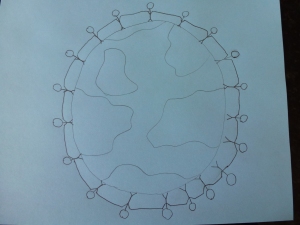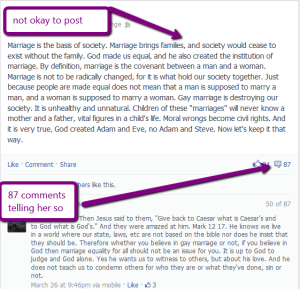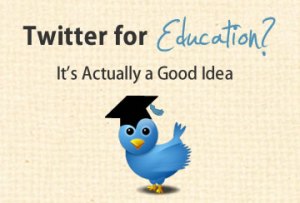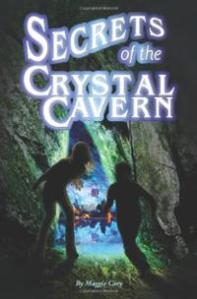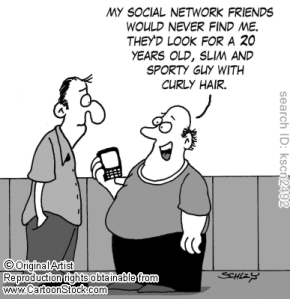This semester in my third module of my introduction to writing arts class called technologies and future of writing my blog group and I have been looking at how new Web 2.0 technologies are changing the rules of etiquette online. We even discovered that there is a new word to refer to etiquette used online or in digital spaces known as “netiquette.” In our presentation for the Pecha Kucha, which has 20 slides with each shown for 20 seconds and only 1 image per slide, we highlighted aspects of “netiquette” online that we think are important for everyone to known in this evolving world of technologies that will continue to grow.
A Walk Through a Slide
In my section of the presentation I discussed the term “netiquette” and how it was derived, along with how rules online are changing and evolving with new technologies. For one of my slides, I wanted to highlight the importance about how new rules form with new technologies and different communities elicit different etiquette rules. For example, when you are on Facebook, you can talk more informally than you would if you were on a professional site looking for a job. This is a crucial point that my group’s blog on etiquette has discussed in many of our posts because we want to make sure people understand “netiquette’s” importance when being online.
I chose to use a quote from Sherry Turkle’s article “Who Am We” that discusses how the Internet links millions of people together and changes how communities are created. I thought that this quote fit in well with this part of the presentation because her quote ties into the point that we are linked to so many people on the Internet that we need to be aware of online “netiquette” rules that different sites and online communities have. It also drives home the point that how we act and behave online effects more than just ourselves, and this is why we need to be conscious of “netiquette” rules. Also, my picture for this slide was a sketch of a world with people around it linked together. I thought it fit in well with Turkle’s quote and brings into perspective that what we write online links us to people all over the world. Therefore, we need to be aware of our actions in different online spaces. I also mention how it can be hard to learn all the new “netiquette” rules because they are learned through experience and are constantly changing. I think that this is important because everyone will make mistakes online, and it is understandable, but we need to realize that how we act online effects more than just us. I would say a good tip is to think before you post or press send.
I wanted this slide to really drive home the point that “netiquette” rules are important to be aware of when using online spaces. I think, as a part of my 5 slides in the presentation, it allows people to see that “netiquette” rules are important because of how expansive the Internet allows our connections and communities to be and every site is different in terms of their rules. It also sets up the fact that new “netiquette” rules will continue to evolve because of the new technologies and online spaces being developed every day. My slide builds on the idea that our world will not stop developing and evolving technologies, so “netiquette” is important to keep in mind when interacting on the Internet daily, whether in be in online games, social media, or professional sites. I mention that the rules are hard to learn, but I think if I had to change something about this slide, it might be adding in the fact that everyone will make mistakes online, but we need to be award of our actions and how they affect. This allows people to feel that it is alright if they would make a mistake, but to maybe think next time about how their actions will affect others and reconsider pressing send.
What I Learned about my Blog Topic
Over the past few weeks, I have really learned a lot about our topic of etiquette in online spaces. I think that looking more into this topic has taught me just how expansive and ever-changing Web 2.0 technologies are, and how etiquette online is becoming an important aspect of this growth. I mean the whole reason for the term “netiquette,” or network and Internet etiquette, is because of the new Web 2.0 technologies that are gaining in popularity each day. In “Who Am We” by Sherry Turkle, she discusses how people assume different online identities when on the Internet, but more importantly that “the Internet links millions of people in new spaces that are changing the way we think and the way we form our communities.” This really make me think just how important “netiquette” really is because if we are linked to so many people through the Internet, than we are effecting more than just ourselves when we post, write, or act a certain way online. I think that by interacting more in online spaces, especially Twitter, I have seen how much social media connects us to other people. Social media has its advantages, and if we are aware of our actions and how we behave online, it can be a great way to connect and communicate with others.
Another important thing that I learned about online etiquette is that there are different rules for different sites, which can make them hard to learn because you learn through experiences and observations online. On a blogging site called Gigaom, in an article titled “The Future of Online Etiquette is Already Here-It’s Just Unevenly Distributed” written by Matthew Ingram he says, “As anyone who has missed an important email knows by now, modern communications etiquette is a minefield of unspoken expectations and potential anxiety-inducing behavior.” This quote allowed me to realize that because of all the new Web 2.0 technologies, and with the rules not written down, we are expected to know what the online etiquette rules are, which can cause for anxiety and stress. Ingram also points out that this is because people are at different stages in their evolution from one technology to another. Everything is changing and evolving so quickly, that it can be hard to keep up with all the new etiquette practices.
Overall, I have learned that “netiquette” has become such an important part of our world because of how much Web 2.0 technologies are evolving and changing. It will not go away either because children in this generation and generations to come will grow up in the age of technology. It will affect how they apply to college or interact with the world. New technologies already impact how we interact on a daily basis. I think one of the major things that I learned is that we need to be aware of how we act online because you never know who you are effecting. Learning the new “netiquette” rules will allow for more effective communication in online and digital spaces.
